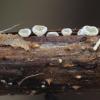
22-12-2025 00:47
Patrice TANCHAUDBonsoir, récolte à proximité du milieu dunaire

21-12-2025 21:32
Pol DebaenstHello, Garden, Burgweg 19, Veurne, BelgiumOn 10/1

21-12-2025 21:40
Isabelle CharissouBonjour, j'aimerais connaitre les références de

21-12-2025 21:31
Pol DebaenstHello, Garden, Burgweg 19, Veurne, BelgiumOn 10/1

21-12-2025 21:31
Pol DebaenstHello, Garden, Burgweg 19, Veurne, BelgiumOn 10/1

20-12-2025 23:08
Patrice TANCHAUDBonsoir, récolte sur sol sablonneux dans l'arri�

21-12-2025 09:32
Hello.A tiny ascomycete found embedded in wood in

20-12-2025 15:47
Mirek GrycHi.These grew on pine wood that was heavily covere
 Hello
HelloI have found this nice Lachnum on last years stem of Rubus idaeus. I firstly thought it was L. clavigerum, but it has a colour change - first yellow as seen on the photo later red-brownish. Also the spores are to big.
Sp. elipsoid-flattened elipsoid, 9-12 x 2-2,5. Asci approx. 55 x 4 µm without croziers, J+ (blue). Hairs cylindrical with warts/spines, some with crystals on the top. Paraphyses fusiform 3,5 µm broad
Cheers
Rasmus

Hello Rasmus,
in Lachnum you should first note 3 things:
- croziers (you did and say no)
- contents of living paraphyses (and hairs) - with or without a large amount of vacuolar guttules. I suggest: no
- crystals on the hairs. You do not mention then, so I think no.
L. clavigerum (as far as I have it in my mind correctly) has crystals on the hairs. I never found it on Rubus, but (as far as I remember) on Epilobium angustifolium.
The most common species on Rubus is L. virgineum - what do you think?
Best regards, Lothar

Thanks for the comments!
A lot of the hairs does in fact have crystals on the top. Also the colour change when bruised is quite distinct and not present in L. virginum as far as i know.
Best regards
Rasmus

I have a clavigerum folder for Rubus idaeus, with several samples (including HB 8585).
The spectrum of the species includes also Aruncus etc. I am not sure if there are any clear differences between the substrates, except for spore size:
9-11 x 2-2.5 on Rubus
6-9 x 1.7-2 on Epilobium/Aruncus
So perhaps two species?
Rasmus' description includes crystals. The colour change would point to VBs in the paraphyses and hairs, but for a species with crystals this is impossible. Actually, a yellowish-cream disc is not unusual in L. clavigerum.
Zotto

